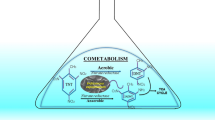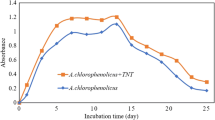Abstract
Current study reports isolation of newly isolated slight halophilic bacteria which can utilize 2,4,6-trinitrotoluene (TNT) as a sole nitrogen source, leading to its detoxification. Among 100 halo(alkali)tolerant and halo(alkali)philic strains were isolated from TNT-contaminated soil, two slight halophilic alkalitolerant strains showed remarkable ability to quickly remove the different concentrations of TNT up to 200 mg/L during 24 h in aerobic condition. Phylogenetic analysis indicates that both strains belonged to the genus Pseudomonas which were able to grow aerobically in different concentrations of NaCl (up to 5 and 10%, respectively), temperature (25–40°C), and pH (7–9). Kinetic studies of TNT biotransformation process showed this growth-associated process followed the first-order expression with parameters of kd: 0.09–0.11 mg/(L h), Т1/2: 6–7 h, μ: 0.17–0.25 1/h leading to a removal of 90% of TNT (100 mg/L) during a 24 hour period. Finally, the growth rate of both strains evaluated on minimal and complex media, and growth parameters were optimized for maximum growth and most likely maximum biotransformation.





Similar content being viewed by others
REFERENCES
Amoozegar, M.A., Salehghamari, E., Khajeh, K., Kabiri, M., and Naddaf, S., Production of an extracellular thermohalophilic lipase from a moderately halophilic bacterium, Salinivibrio sp. strain SA-2, J. Basic Microbiol., 2008, vol. 48, no. 3, pp. 160–167.
Amoozegar, M.A., Malekzadeh, F., and Malik, K.A., Production of amylase by newly isolated moderate halophile, Halobacillus sp. strain MA-2, J. Microbiol. Methods, 2003, vol. 52, no. 3, pp. 353–359.
Asad, S., Amoozegar, M.A., Pourbabaee, A., Sarbolouki, M.N., and Dastgheib, S.M.M., Decolorization of textile azo dyes by newly isolated halophilic and halotolerant bacteria, Bioresour. Technol., 2007, vol. 98, no. 11, pp. 2082–2088.
Atlas, R.M., Handbook of Microbiological Media, 3rd ed., Washington, D.C: CRC, 2010.
Ayoub, K., van Hullebusch, E.D., Cassir, M., and Bermond, A., Application of advanced oxidation processes for TNT removal: a review, J. Hazard. Mater., 2010, vol. 178, no. 1, pp. 10–28.
Boopathy, R., Wilson, M., Montemagno, C.D., Manning, J.F. and Kulpa, C.F., Biological transformation of 2,4,6-trinitrotoluene (TNT) by soil bacteria isolated from TNT-contaminated soil, Bioresour. Technol., 1994, vol. 47, no. 1, pp. 19–24.
Chien, C., Kao, C., Chen, D.-Y., Chen, S.C., and Chen, C., Biotransformation of trinitrotoluene (TNT) by Pseudomonas spp. isolated from a TNT-contaminated environment, Environ. Toxicol. Chem., 2014, vol. 33, no. 5, pp. 1059–1063.
DasSarma, S. and DasSarma-Priya, P., Halophiles, ELS, 2001, pp. 1–13.
Esteve-Núñez, A., Caballero, A., and Ramos, J.L., Biological degradation of 2,4,6-trinitrotoluene, Microbiol. Mol. Biol. Rev., 2001, vol. 65, no. 3, pp. 335–352.
Federation, W.E. and Аmerican Public Health Association, Standard Methods for the Examination of Water and Wastewater, Washington, DC: American Public Health Association (APHA), 2005.
Fiorella, P.D. and Spain, J.C., Transformation of 2,4,6-trinitrotoluene by Pseudomonas pseudoalcaligenes JS52, A-ppl. Environ. Microbiol., 1997, vol. 63, no. 5, pp. 2007–2015.
French, C.E., Nicklin, S., and Bruce, N.C., Aerobic degradation of 2, 4, 6-trinitrotoluene by Enterobacter cloacae PB2 and by pentaerythritol tetranitrate reductase, Appl. Environ. Microbiol., 1998, vol. 64, no. 8, pp. 2864–2868.
Garrity, G.M., The archaea and the deeply branching and phototropic bacteria, in Bergey’s Manual of Systematic Bacteriology, vol. 1, Boone, D.R. and Castenholz, R.W., Eds., Baltomore: Springer, 2001.
Hudcova, T., Halecky, M., Kozliak, E., Stiborova, M., and Paca, J., Aerobic degradation of 2,4-dinitrotoluene by individual bacterial strains and defined mixed population in submerged cultures, J. Hazard. Mater., 2011, vol. 192, no. 2, pp. 605–613.
Kalafut, T., Wales, M.E., Rastogi, V.K., Naumova, R.P., Zaripova, S.K., and Wild, J.R., Biotransformation patterns of 2,4,6-trinitrotoluene by aerobic bacteria, Curr. Micr-obiol., 1998, vol. 36, no. 1, pp. 45–54.
Krulwich, T.A. and Guffanti, A.A., Physiology of Acidophilic and Alkalophilic Bacteria, Advances in Microbial Physiology, London: Elsevier, 1983, vol. 24, pp. 173–214.
Kulkarni, M. and Chaudhari, A., Biodegradation of p-nitrophenol by Pseudomonas putida,Bioresour. Technol., 2006, vol. 97, no. 8, pp. 982–988.
Kuppusamy, S., Thavamani, P., Megharaj, M., Lee, Y.B., and Naidu, R., Kinetics of PAH degradation by a new acid-metal-tolerant Trabulsiella isolated from the MGP site soil and identification of its potential to fix nitrogen and solubilize phosphorous, J. Hazard. Mater., 2016, vol. 307, pp. 99–107.
Li, L., Wang, J., Zhou, J., Yang, F., Jin, C., Qu, Y. Li, A., and Zhang, L., Enhancement of nitroaromatic compounds anaerobic biotransformation using a novel immobilized redox mediator prepared by electropolymerization, Bioresour. Technol., 2008, vol. 99, no. 15, pp. 6908–6916.
Margesin, R. and Schinner, F., Potential of halotolerant and halophilic microorganisms for biotechnology, Extremophiles, 2001, vol. 5, no. 2, pp. 73–83.
Martin, J.L., Comfort, S.D., Shea, P.J., Drijber, R.A., and Kokjohn, T.A., Denitration of 2,4,6-trinitrotoluene by Pseudomonas savastanoi,Can. J. Microbiol., 1997, vol. 43, no. 5, pp. 447–455.
Moshe, S.S.-B., Ronen, Z., Dahan, O., Weisbrod, N., Groisman, L., Adar, E., and Nativ, R., Sequential biodegradation of TNT, RDX and HMX in a mixture, Environ. Pollut., 2009, vol. 157, nos. 8–9, pp. 2231–2238.
Oh, B.-T., Shea, P.J., Drijber, R.A., Vasilyeva, G.K., and Sarath, G., TNT biotransformation and detoxification by a Pseudomonas aeruginosa strain, Biodegradation, 2003, vol. 14, no. 5, pp. 309–319.
Pak, J.W., Knoke, K.L., Noguera, D.R., Fox, B.G. and Chambliss, G.H., Transformation of 2,4,6-trinitrotoluene by purified xenobiotic reductase B from Pseudomonas fluorescens I-C, Appl. Environ. Microbiol., 2000, vol. 66, no. 11, pp. 4742–4750.
Park, C., Kim, T.-H., Kim, S., Kim, S.-W., Lee, J., and Kim, S.-H., Optimization for biodegradation of 2,4,6-trinitrotoluene (TNT) by Pseudomonas putida,J. Biosci. Bioeng., 2003, vol. 95, no. 6, pp. 567–571.
Pennington, J.C. and Brannon, J.M., Environmental fate of explosives, Thermochim. Acta, 2002, vol. 384, no. 1, pp. 163–172.
Rahal, A.G. and Moussa, L.A., Degradation of 2,4,6-trinitrotoluene (TNT) by soil bacteria isolated from TNT contaminated soil, Aust. J. Basic Appl. Sci., 2011, vol. 5, pp. 8–17.
Saitou, N. and Nei, M., The neighbor-joining method: a new method for reconstructing phylogenetic trees., Mol. B-iol. Evol., 1987, vol. 4, no. 4, pp. 406–425.
Schackmann, A. and Müller, R., Reduction of nitroaromatic compounds by different Pseudomonas species under aerobic conditions, Appl. Microbiol. Biotechnol., 1991, vol. 34, no. 6, pp. 809–813.
Singh, S.N. Biological Remediation of Explosive Residues, Springer, 2013.
Stanley, J.K., Lotufo, G.R., Biedenbach, J.M., Chappell, P., and Gust, K.A., Toxicity of the conventional energetics TNT and RDX relative to new insensitive munitions constituents DNAN and NTO in Rana pipiens tadpoles, Environ. Toxicol. Chem., 2015, vol. 34, no. 4, pp. 873–879.
Wittich, R.-M., Haïdour, A., Van Dillewijn, P., and Ramos, J.-L., OYE flavoprotein reductases initiate the condensation of TNT-derived intermediates to secondary diarylamines and nitrite, Environ. Sci. Technol., 2008, vol. 42, no. 3, pp. 734–739.
Ziganshin, A.M., Naumova, R.P., Pannier, A.J., and Gerlach, R., Influence of pH on 2,4,6-trinitrotoluene degradation by Yarrowia lipolytica,Chemosphere, 2010, vol. 79, no. 4, pp. 426–433.
ACKNOWLEDGMENTS
The authors gratefully acknowledge University of Tehran, Tehran University of Medical Sciences, and Kharazmi University for supporting this study.
Author information
Authors and Affiliations
Corresponding author
Ethics declarations
CONFLICT OF INTEREST
The authors declare that they have no conflict of intere-st.
ETHICAL APPROVAL
This article does not contain any studies with human participants or animals performed by any of the authors.
Supplementary material
Rights and permissions
About this article
Cite this article
Ali-Begloui, M., Salehghamari, E., Sadrai, S. et al. Biotransformation of Trinitrotoluene (TNT) by Newly Isolated Slight Halophilic Bacteria. Microbiology 89, 616–625 (2020). https://doi.org/10.1134/S0026261720050033
Received:
Revised:
Accepted:
Published:
Issue Date:
DOI: https://doi.org/10.1134/S0026261720050033




